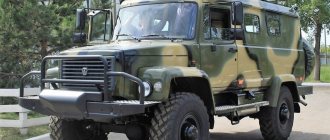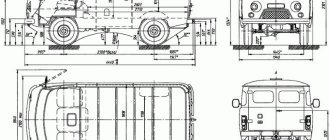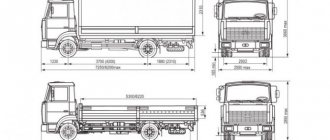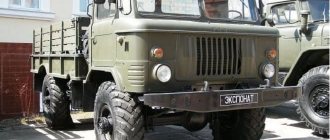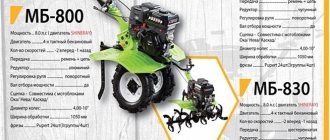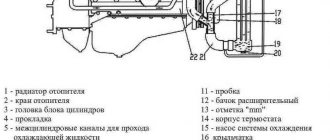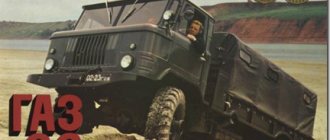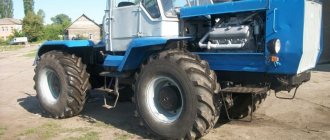Tire profile (height) for models of different years of manufacture.
Disclaimer: Although the data represents official manufacturer figures, the information above is for reference only and is not guaranteed to be absolutely accurate.
Tires absorb shocks from road unevenness, significantly unloading the suspension parts.
Modern cars are equipped with pneumatic tires, which can be tubed or tubeless.
On GAZ-53A, GAZ-51A and ZIL-130 vehicles, a tube tire is used, consisting of a tire, a tube with a valve and a rim tape that protects the tube from abrasion by the wheel rim and pinching by the edges of the tire.
Tire section
Tire cut:
1 — bead core (wire ring); 2 - sidewall; 3 - frame; 4 - cushion layer; 5 — protector; 6 - board.
The tire consists of a frame 3, a cushion layer 4, a tread 5, sidewalls 2 and beads 6.
The frame is made of several layers of rubberized fabric - cord and is firmly attached to the rigid beads that secure the tire to the wheel rim. The sides are embedded with cores (rings) made of steel wire wrapped in tape. The rings prevent the beads from stretching and prevent the tire from slipping off the wheel.
The cushion layer of rubber lying between the tread and the frame protects the latter from damage. The tread pattern depends on the purpose of the tire.
The chamber is a closed rubber sleeve into which air is pumped through a valve built into it - a valve that allows air only into the chamber.
Valves
a - metal; b - rubber-metal;
1 - body; 2 — cap-key; 3 - nipple; 4 - valve; 5 - spring; 6 - sealing washer; 7 - camera; 8 — valve washer; 9 - nut; 10 - rubber body.
The main parts of the valve are a rubber-metal or metal body, a spool consisting of a nipple and a valve with a spring, and a cap. When the tire is inflated, the valve opens from the air pressure, overcoming the elastic force of the spring, and when the air supply stops, the spring closes the valve and, therefore, the release of air from the chamber becomes impossible.
To make it easier to inflate air with a tire pump, the tip of its hose is equipped with a rod, which, when connecting the hose to the valve, forcibly opens the valve. When the hose tip is unscrewed from the valve, the valve is released.
Tire sizes
D—outer diameter; d—inner diameter; B and H are the width and height of the profile.
Their dimensions in inches or millimeters are marked on the side surface of the tire and tube. The first number indicates the width of the profile B, the second - the diameter d of the wheel rim.
Tire sizes and air pressure are shown in the table.
For a GAZ-53A car, the tire is mounted on a disk with a wide rim, which is held on it by one bead and a locking ring.
On a GAZ-51A car, the tire is held on the rim by two rings: a bead ring and a lock ring.
Wheel disc with a flat rim of a GAZ-51A car
Wheel disc with a flat rim of the GAZ-51A car:
1 - rim; 2 — disk; 3 — removable side ring; 4 - locking ring.
Tube or tubeless tires are installed on the one-piece deep rim of the wheel of the Moskvich-412 car. A tubeless tire does not have a tube, and air is retained in it due to the tight connection between the tire and the beads of the wheel rim. The valve is installed directly in the rim.
Deep rim wheel rim and tire
Wheel rim with deep rim and tire of the Moskvich-412 car:
1 - camera; 2 - valve; 3 — tire; 4 - rim; 5 - disk.
Tire pressure is checked with a tire pressure gauge.
Tire faults
Their main faults are: wear, punctures and cuts, delamination and rupture of the frame. Most often, tires wear out quickly due to non-compliance with air pressure standards in them. If the pressure increases, the contact surface of the tire with the road is reduced, wear of the central part of the tread increases, the tire loses elasticity, the cord threads are overstressed and break. At reduced pressure, the tire frame becomes more deformed and quickly collapses. Damaged tires are repaired or replaced with new ones.
Tire care
To increase tire life you must:
- inspect the tires daily to ensure there are no cuts, tears or visible damage;
- remove sharp objects from the tread and stones, bricks, etc. stuck between the dual tires of trucks; maintain normal tire pressure; timely rearrange wheels and tires according to the scheme. The durability of tires can be significantly increased if you follow the rules of vehicle operation.
Scheme for rearranging wheels and tires on GAZ-53A and GAZ-51A vehicles
It is impossible to indicate exact values. Drivers must be guided by the data specified in the vehicle passport.
In doing so, they should take into account factors such as:
- quality of road surface;
- car condition;
- season;
- climate (in particular, air temperature);
- type of tires used.
Manufacturers calculate pressure in an effort to reduce tire wear and fuel consumption. This approach, if there are a lot of bumps and potholes, will lead to excessive shaking and loss of dental crowns. The optimal pressure will have to be determined directly by the vehicle owner.
The main thing is not to exceed the maximum values indicated on the side of the tire. Otherwise, serious problems with driving the car cannot be avoided. Low pressure provokes an increase in braking distance. In the absence of appropriate knowledge and experience, the driver should contact a service station specialist.
The pressure in GAZ 66 and 53 tires is of great importance. If the tires are not inflated correctly, the proportionality of the load on the rear of the truck will be disrupted. To prevent vehicle malfunctions, air density must be checked regularly. First, the pressure is checked when the car's tires are cool. The air inside the tires compresses and expands. These changes are caused by temperature. A long ride can increase tire pressure by up to 25%.
The lineup
The GAZ 53 family includes medium-duty trucks equipped with an eight-cylinder engine. The first models were released in 1961; production of cars from this series was stopped in 1993. They were replaced by a GAZ 3307 car.
Among the main modifications of this truck there are both civilian and military versions. A separate category includes dump trucks, the KAVZ-685 bus and models that operate on liquefied gas.
GAZ 66 began production in 1964. All-wheel drive cabover trucks were developed for the military. They are characterized by high all-terrain qualities.
They are explained by the presence of the following features:
- self-locking axle differentials;
- high ground clearance;
- centralized system for regulating air density in tires;
- four-wheel drive.
About the areas of application and modifications of the GAZ-53
On its not particularly powerful shoulders, the GAZ-53 nevertheless “rolled” at least half of the entire economy of the Country of Soviets. It's hard to find where this ubiquitous truck has NOT been used. From the “gait” for emergency crews and the “paddy wagon” for criminals to mobile fuel tankers and truck tractors that hauled containers - everything that was not installed on the GAZ-53 chassis!
These cheap, simple and unpretentious trucks have become widespread in agriculture. In the 70s/early 80s of the 20th century, on the average Soviet collective farm, 80% of the truck fleet consisted of GAZ-53. Only in the second half of the 80s did this ratio begin to change towards an increase in the share of ZIL-130, which, by the way, in Soviet times did not cost much more than GAZon.
GAZ-53 of the 60s and 80s both look noticeably different from each other, and in a technological sense these are two quite different trucks. Not only are their engines completely different, but also many other design elements.
After all, over the years of production, the GAZ-53 has experienced three major and many minor upgrades and improvements. The Gorky Automobile Plant tried to promptly respond to “signals from the field” and eliminate problems identified during operation.
Thus, already in the first years of the distribution of the new truck model across the country, it became obvious that the axles from the previous generation - GAZ-51, were no longer suitable for the 53rd, and the 82-horsepower engine from the 51st GAZon, although forced, did not respond the increased needs of the new machine. During 1964/65, serial production of the GAZ-53 was launched, equipped, instead of an in-line six-cylinder engine, with a V-shaped eight (115-horsepower ZMZ-53 engine), as well as modified and reinforced axles.
An interesting, half-forgotten fact: the cladding and, accordingly, the appearance of the GAZ-53 of the first releases were very noticeably different from the appearance of the car we are accustomed to. For example, the headlights were located above the direction indicators. However, unfortunately, not a single original LAWN of that very first generation has survived to this day. But he remained captured on film in some famous films of that time, in particular “Happy Troubles” (1964), “Foreigner” (1965), “Beware of the Car” (1966), “Three Poplars on Plyushchikha” (1967).
GAZ-53F (1961—1967)
By the way, a curious film curiosity is associated with the GAZ-53, which has already become familiar to everyone. In the famous film “The Meeting Place Cannot Be Changed,” in the episode when gang members are driving Volodya Sharapov in a GAZ-AA bread van through Moscow at night, a green GAZ-53 was inappropriately included in some shots. (The film takes place in 1946).
"GAZ-53A" (1965–1983)
Three main, basic modifications of the truck rolled off the assembly line under the following factory indices:
- GAZ-53F (1961-1967) - flatbed truck and universal chassis with a forced in-line 6-cylinder GAZ-51 engine with a power of 82 hp.
- GAZ-53A (from June 1965 to 1983) - flatbed truck, dump truck and universal chassis with a ZMZ-53 engine - V-shaped 8-cylinder, 115 hp.
- GAZ-53-12 (from 1983 to January 1993) - flatbed truck, dump truck and universal chassis with an eight-cylinder V-shaped engine ZMZ-53-11 with a power of 120 hp.
According to the power, the load capacity of the three generations of the 53rd LAWN also differs. The GAZ-53F was declared to have a 4-ton capacity, although in fact it only carried 3 tons on board, and 4 tons was an almost unbearable load for it. The GAZ-53A became a real four-ton truck. The power of the GAZ-53-12 engine already allowed it to freely carry not only the 4.5 tons declared by the manufacturer, but also 5 tons “with kopecks”.
GAZ-53-12 (1983-1993)
In addition to the basic ones, there are dozens of modifications and versions of the GAZ-53 made on their basis, intended for use for specialized purposes. Among them -
- Military modification of the GAZ-53N with an additional 105 liter fuel tank, a pre-heater and a set of additional equipment.
- The widely used KAVZ-685 and Kuban based on the GAZ-53. They were produced on the GAZ-53-40 chassis, equipped with softer springs and telescopic shock absorbers, a fuel tank from the GAZ-66, a modified brake system and electrical equipment.
- GAZ-53-02 – dump truck.
- A special chassis designed for the GAZ-SAZ dump truck (SAZ-3503).
- GAZ-53-05 is a truck tractor (it was not widely used, because any of the three engines of the 53rd GAZon was too weak for such “exercises”).
- GAZ-53-19 and GAZ-53-27 - versions developed in 1984, running on liquefied gas; with engines of 105 and 100 hp. respectively.
GAZ-53 trucks were exported to almost all socialist countries, and from capitalist countries to Finland and Belgium.
Serious assembly production of these trucks, from Soviet vehicle kits, was organized in Bulgaria and Cuba. Moreover, the Bulgarian enterprise Madara produced the GAZ-53 from 1967 to 1991, increasing production volume to 3,000 cars per year in the 80s. And already from the beginning of the 70s, it equipped them with Bulgarian-made engines.
Export versions of the truck were produced with the factory designations GAZ-53-70 and GAZ-53-50 (especially for the tropics). As already noted, the number of specialized versions based on the GAZ-53 chassis is difficult to calculate. These include mobile repair shops, fire trucks, truck cranes, ladder trucks, garbage trucks, loader cranes, fuel tankers, etc. and so on.
From the history of the creation of GAZ - 66
The GAZ-66 was launched into mass production in 1964. It was created on the basis of the GAZ-62 and GAZ-63 trucks. The all-wheel drive truck had a payload capacity of 2 tons, a V-shaped eight-cylinder gasoline engine and a 4-speed gearbox. In 1968, a tire pressure regulation system was added to the GAZ-66 design. The model was twice awarded gold medals and received a quality mark. The production of GAZ-66 ceased in 1995, at the moment you can purchase GAZ 66 from military conservation.
Due to what the high cross-country ability of GAZ - 66 was achieved
A number of factors influenced the truck’s high cross-country ability. First of all, this is the use of self-locking differentials in both axles of the car. It is important to shift the center of gravity to the middle of the body, which gives an even distribution of the load on both axles of the car.
Detailed diagram of the GAZ 66 truck The high landing of the body allowed the truck to crawl through swampy terrain without touching the bumps and hummocks with its “belly”. Also, due to the short overhangs, the GAZ-66 truck easily overcomes uneven sections of the road. Tires also affected cross-country ability. It’s worth talking about tires in more detail.
Cabin GAZ-53
“A comfortable 2-seater closed cabin, convenient location of controls and instruments, good visibility, reliable brakes, and the presence of powerful lights ensure ease of driving and safety at high speeds at any time of the day,” this is how the GAZ-53 information album described “ VneshTorgIzdata" in 1968.
Well, as they say, what to compare with. From the perspective of our time, the cabin of the GAZ-53 is more than ascetic and spartan.
However, compared to the same GAZ-51, which did not have synchronizers in the gearbox, the clutch had to be depressed 2-3 times before engaging, and the cabin was cramped and poorly heated, the 53rd was simply the pinnacle of comfort!
The two-seater shared sofa seat, covered in faux leather, could easily accommodate three people if desired. The only point: the one who got the seat in the middle could interfere a little with the driver by touching the gearshift lever with his feet. There was also ample space in the cabin for the “creativity” of tuning enthusiasts: Soviet-era drivers decorated their GAZ-53 cabs as best they could.
There were also craftsmen who made homemade insulation and soundproofing of the cabin: they filled it with foam plastic, lined it with felt, achieving amazing silence and comfort in their workplace.
The need to monitor tire pressure
Drivers should carefully monitor the condition of their car. Control checks must be carried out at least twice a month.
After the next pumping, the pressure drops by 0.4 bar over the course of a month, so if this indicator is not adjusted in a timely manner, the risk of an accident increases.
Tires are an essential element of passenger cars and trucks. Their function is to soften road irregularities. If your tire pressure is too low, your tire grip will be reduced. If the wheels are turned incorrectly, their frame may collapse. The braking process of a vehicle depends on the quality of the tires.
Thanks to constant monitoring of tire pressure you can:
- reduce the load on the suspension;
- increase the service life of tires;
- reduce fuel consumption.
The passport of each vehicle (regardless of the load capacity) indicates the recommended pressure. Air density is determined by the manufacturing plant.
Technical characteristics of GAZ-53-12
- Engine: ZMZ-53, 115 l. s./3200 rpm.
- , 4-stroke, carburetor, 4254 cm³. Bore/Stroke: 92/80 mm
- Gearbox: 4 forward + 1 reverse
- Length: 6395 mm,
- width: 2280 mm,
- height: 2190 mm
- Base: 3700 mm,
- ground clearance: 265 mm
- Curb weight: 3200 kg
- Load capacity: 4500 kg
- Tire size: 240-508 mm
- Fuel tank capacity: 90 l
- Maximum speed with full load on the highway: 90 km/h[1]
- Control fuel consumption at a speed of 40 km/h: 24 l/100 km
About the technical characteristics of the GAZ-53
Having looked at photographs of other cars of the late 50s/early 60s, we can rightfully say that for its time the appearance of the cabin and its interior of the GAZ-53 looked very progressive.
A one-piece lining of the radiator grille was made, into which the headlights and sidelights were organically integrated. The driver and passenger seats, according to the canons of those years, were a single “sofa”. However, the ergonomics of the workplace were better thought out than in the GAZ-51.
According to its class, the GAZ-53 belongs to the family of universal medium-duty multi-purpose trucks. The GAZ-53 truck has a frame structure, the wheels are driven to the rear axle.
dimensions
- Length – 6.395 m; width – 2,380 m; height (in the cabin, without load) – 2,220 m
- Chassis base – 3,700 m; front wheel track (on ground) – 1,630 m; rear wheel track – 1,690 m
- Ground clearance: 265 mm. In this case, the lowest points with full load are: 265 mm (rear axle housing) and 347 mm (front axle).
- Dimensions of the cargo platform: length – 3,740 m; width – 2,170 m; side height – 0.68 m.
- The turning radius along the track of the outer front wheel is 8 m.
Performance characteristics
- Wheel formula: 4x2.
- Curb weight: 3.2 tons.
- Load capacity: 4 tons for GAZ-53F and GAZ-53A; 4.5 tons - for GAZ-53-12.
- Tire size: 8.25-20 inches.
- Maximum permissible weight of towed trailer: 4 tons.
- The GAZ-53 cabin is metal, two-seater, two-door.
- Maximum speed with full load on a horizontal highway: 90 km/h.
- Fuel tank capacity: 90 l (in the military version of the GAZ-53N - 105 l).
- Fuel consumption from 24 liters of gasoline per 100 km.
A few words about the characteristics of the GAZ-53-02 version (dump truck). The LAWN dump truck was produced with a frame shortened by 27 cm at the rear. The wheelbase remained the same. Was equipped with a power take-off shaft.
The platform was equipped with a gear-type hydraulic pump, which, through a system of control valves, ensured the operation of a three-link hydraulic cylinder for lifting the body. The capacity of the all-metal body platform is 5 cubic meters; body lifting and unloading are provided both backwards and sideways.
GAZ-53 engines
8-cylinder 4-stroke gasoline carburetor engines ZMZ-53 and ZMZ-53-11 have a V-shaped cylinder arrangement. The working volume is 4,254 cubic centimeters. Power, at 3200 rpm per minute is: 115 (ZMZ-53) and 120 (ZMZ-511) horsepower. Cylinder diameter – 92 mm; piston stroke – 80 mm. The average compression ratio is 6.7. The maximum torque at 2000-2500 rpm is 29 kg/cm. The cylinders operate in the following order: 1—5—4—2—6—3—7—8.
The engine cylinder block is made of casting from Al-4 alloy, and after casting it is sealed by heat treatment and impregnation with synthetic resin. This is a classic monoblock V-shaped design with an angle along the cylinder axes of 90 degrees.
The cavities of the block and cast iron liners for the pistons form the water cooling jacket of the engine. The possibility of repair replacement of sleeves is provided (5 groups with letter designations). The clutch housing is secured to the end of the block with threaded rods.
Pistons are also divided into five repair groups according to their diameter (letter marking), and into four groups according to the diameter of the piston pin holes (color marking). The piston group is cast from aluminum alloy “Al-30”. The piston has a classic round shape with a flat bottom; three grooves are cut along its diameter for oil scraper and compression rings.
The block heads are made of Al-4 alloy. The valve seats are made of cast iron, and the guide bushings are made of copper-graphite ceramics. The block and cylinder heads are connected by threaded rods through gaskets made of asbestos cardboard reinforced with steel. The crankshaft is cast from cast iron, on which the connecting rod journals, bearings and counterweights are formed.
The crankshaft went through a series of mandatory dynamic and static balancing. Axial movement of the crankshaft is eliminated by two washers installed on either side of the first journal support. It is sealed in the block using oil-squeezing grooves, oil seals and asbestos packing.
The gas distribution mechanism, with overhead valve installation, ensures the intake of the fuel-air working mixture into the cylinders and the exhaust of exhaust gases.
This device consists of: camshafts and gears, pushers, rocker arms, rods, valves, guide bushings and springs. The camshaft is forged from steel. It has 5 bearing journals, cams, a gear drive for an oil pump and an ignition distributor.
The device for preparing the gasoline-air mixture is a K-126 carburetor. The ignition system is contact. Spark plugs – A11-U.
The lubrication system supplies oil to the contacting parts of the engine both under pressure and by gravity. The oil pump is gear-type, driven by a camshaft, the oil filter is full-flow, serviceable.
The air preparation filter is also serviceable, inertial, with the settling of polluting particles in an oil bath. Cooling system – with a water pump, closed type, liquid. It consists of a water jacket of the cylinder block, radiator, pump, thermostat, shutters, fan, fan casing, radiator cap and connecting hoses. Capacity – 22 liters.
The engine of the third modification of the 53rd GAZon - ZMZ-53-11 differs from its predecessor in new cylinder heads with increased compression parameters; a sectional oil pump, a full-flow filter device, and crankcase ventilation switched to a closed circuit.
Gearbox, transmission, brake system, chassis, steering
The gearbox consists of four forward “speeds” and one rear. By its design, the GAZ-53 gearbox is a three-way gearbox, with synchronizers in third and fourth gears. The clutch is single-disc, dry.
The cardan transmission is open type, has cardan shafts with needle bearings. The main gear of the drive axles is a conical, hypoid type, with a gear ratio of 6.83. Differential - gear, cam, bevel, limited slip.
Springs – 4 pcs., longitudinal semi-elliptical, ends embedded in rubber supports. The rear suspension has additional springs. Shock absorbers – hydraulic, telescopic, double-acting.
Foot brakes - shoe brakes, 4 wheels. The brake drive is foot-operated, hydraulic, with a hydraulic vacuum booster. The hand brake is central, drum type, mounted on the driven shaft of the gearbox. The type of steering mechanism of the GAZ-53 is a globoidal worm with a 3-ridge roller.
Electrical equipment GAZ-53
The GAZ-53 truck uses a single-wire wiring system with a connection between the negative terminal and ground. The mains voltage is 12 Volts. The brand of the “native” battery is 6-ST-68-EM (“6” is the number of batteries connected in series in the battery, “ST” is the starter battery, “68” is the battery capacity A/h, “EM” is the battery material “miplast” ").
Generator brand, power 350 W – G130-G; relay regulator – PP130. The electrical system of the GAZ-53 truck also includes a B13 ignition coil, with additional resistance; breaker-distributor P13-B; single-cylinder air-cooled compressor; ST130-B electric starter with remote activation.
Possible problems
Due to improperly inflated wheels, vehicle handling suffers, extraneous noise and shaking occur, and tire wear increases. There may be malfunctions in the operation of the vehicle's chassis.
Many drivers note that if the GAZ is on low-pressure tires, they can avoid discomfort when driving on a bad road. In the current circumstances, insufficient tire inflation provides increased smoothness of movement and braking accuracy.
Wheels should only be inflated when they are “cold”. Otherwise, it will be impossible to assess the pressure level.
The pressure in GAZ 66, 53 and 3110 tires is determined according to the table. Among the criteria taken into account are tires (their type), the presence or absence of load, and the location of the wheels. The developed recommendations can be found in the documents attached to the TS.
Truck tires for GAZ 53 are a work of art. They must withstand enormous weight. It is believed that in the USSR they only made reliable things, but now they have forgotten how. It makes me sad to think about it. It’s better to hope that this is not the case, because the safety, life and health of people depend on the quality of tires.
It's important to buy good ones. Some ridiculous statement, a joke on the topic of the day can interfere with choosing the right ones. If you brush aside this obsessive thought and concentrate on the main thing, you will be able to find what you are looking for.
Technical parameters for choosing tires for GAZ 53
Truck tires on GAZ 53 are a work of art.
They must withstand enormous weight. It is believed that in the USSR they only made reliable things, but now they have forgotten how. It makes me sad to think about it. It’s better to hope that this is not the case, because the safety, life and health of people depend on the quality of tires. It's important to buy good ones. Some ridiculous statement, a joke on the topic of the day can interfere with choosing the right ones. If you brush aside this obsessive thought and concentrate on the main thing, you will be able to find what you are looking for.
Arched tires - why are they needed?
For better cross-country ability, there are arched tires. What can you say about them? The distinctive feature of them is a very wide profile - the width of the arched rubber is two or even three times greater than the usual width of an ordinary tire.
Example of arched tires for gas 66
At the same time, the outer size itself remains at a normal level. This design makes it possible to reduce the internal pressure in tires to 0.5-1.4 kgf/cm2, the pressure on the ground is noticeably reduced, distributed over the entire width of the wheel, and due to this, the maneuverability of the equipment is significantly increased.
Tire standards for GAZ 53
Can you always trust the advice of auto repair shop employees? It’s not for nothing that they say: “Trust, but verify.” The owner of the car must understand which wheel is good and which tires are needed. If they are of poor quality, the vehicle will constantly “stumble.” Damage to the body and underbody parts is possible if you choose the wrong wheel size for the GAZ 53.
Electric cars, which are increasingly popular these days, for example, are necessarily protected by a spoiler, because the battery is attached to the bottom. If you choose the wrong tires, the risk of damage may increase.
Tire size for GAZ 53
This truck is a vehicle capable of lifting and transporting medium-tonnage cargo. Produced by the Gorky Automobile Plant since 1961. At the moment, other versions of this legendary truck have replaced it.
Standard wheels GAZ 53
Over the entire production period, more than a dozen different modifications and special versions were made. There are versions that are a ladder truck and a mobile repair shop. Over the entire period, more than four million copies were released. This is the most popular domestic truck in history.
The truck is used in many industries, as well as for the needs of various services, most often in the form of a truck. There is a passenger version, a fire service vehicle, a ladder truck and many others. There are also many different designs and modifications. However, the most common can definitely be called a regular cargo version with a “dump truck” type body. This design makes it possible to transport very heavy and large cargo of various types.
On a note!
For transportation, it is important that the vehicle has maximum reliability, quality and ease of maintenance. GAZ 53 is just such a truck. Time-tested, it is very unpretentious. What is especially important is that parts and spare parts for it are available in almost any store.
The GAZ 53 cargo vehicle, which has become a legend, is used throughout the country with all kinds of terrain and with varying complexity of road surfaces. There are front-wheel drive and rear-wheel drive modifications for different types of terrain. The size of the wheels for the GAZ 53 should allow the vehicle with various drives to perform the necessary tasks and have the maximum level of quality with off-road properties. Quite often, such company cars can be found in rural areas, with difficult conditions for transportation. In such places there are often no roads. In such cases, the main load is placed on the wheels and tires of the car. Therefore, it is necessary to always have spare parts and components on hand. Also important is the ability to independently service the car, even in the absence of suitable conditions for this.
You may be interested in: How to properly seal a cut on a car wheel with a tourniquet
Tire size for GAZ 53 to 20 inches
Stamped wheel rims are the most commonly used for this truck. Their cost is optimal for cars of this type, which allows you to get high quality at a low price. In addition, such products are much easier to repair and maintain. If they fall into a deep hole, the stamped wheels will simply be bent, or even not damaged at all. They can subsequently be straightened at a special service station.
Important!
GAZ 53 cars are often found in the form of a fire modification. In this case, in order to drive in difficult sections of the road, you need to use high-quality tires of a suitable size.
Passenger cars have much less capacity for transporting goods than similar trucks. This is precisely why the legendary GAZ cars were created. But even the reinforced chassis of these vehicles experiences enormous loads. Most of them are also transferred to wheels and tires of any diameter, and therefore their maximum quality and wear resistance are extremely important.
During the time when GAZ 53 trucks were produced, wheel products for these vehicles became widespread. Specialized stores currently offer a huge number of various product options. In order not to experience difficulties during operation, professionals recommend choosing original spare parts supplied by the manufacturer. A set of such products in original design will allow you to obtain the highest level of quality and guarantee that the products will exactly fit the truck.
However, there are times when you need to save money. In this case, the network offers a wide selection of used models of both tires and wheels. This is the cheapest and most economical purchase option.
The main thing is to check the products before purchasing for wear and possible hidden damage. This will help avoid unexpected problems during their operation. If, nevertheless, the decision to buy used wheels or tires has been made, and such a set has been purchased, then they can be restored and painted in one of the specialized centers.
In order not to make a mistake with the selection, it is important to understand what types of tires exist for the GAZ 53 according to seasonality. And they are divided into the following:
- Winter. These modifications, in turn, are divided into studded and regular.
- Summer.
- All-season.
Note!
The weight of a GAZ 53 tire is about 43 kilograms, which makes replacing them yourself difficult.
The issue of choosing and purchasing wheeled products is often difficult. In such a case, there are several different methods, among which the following are common:
- Order in the online store. At the moment this is one of the most common and popular methods. However, you need to thoroughly check the seller's reputation.
- Purchase at a regular specialty store. This will allow you to look at the wheels live, touch them and immediately pick up the option you like. Among the negative aspects is the limited number of options presented.
You may be interested in this: Why do wheels squeak when turning?
Tire pressure
Pressure sensor for GAZ 53
The tire pressure of a GAZ 53, a dump truck with radial wheels, must correspond to the following indicators:
In the case of diagonal ones, slightly different values are relevant, namely:
- for front wheels 280 kPa,
- for rear 500 kPa.
Truck GAZ 53
If the pressure in the GAZ 53 tires is less than these values, it means that they will wear out faster, road grip will be reduced and the car will skid to the side from time to time. It is very risky to drive a car whose tires have less than recommended air pressure. It is pointless to hope that a truck will remain stable due to its weight.
If these values are exceeded, nothing good should be expected either. If you fall into a hole, you can damage the disk. Road grip levels are also reduced.
When buying tires on Avito or at a car market, you can count on the air pressure being normal and the spare tire being ready for use. But is this always the case? It's easy to check how many atmospheres there are. This service is available at many gas stations.
The main thing is to let the car cool down a little after driving. This is a prerequisite for obtaining an objective assessment of the situation. How many atmospheres are in the rubber depends on the temperature of the pumped air and neighboring parts. As they move, they heat up and the pressure increases. If you immediately inflate or lower the wheels, they will last longer.
Tires used on GAZ - 66
The influence of tires on cross-country ability
The wheels also help the all-terrain vehicle from the Gorky plant to overcome any obstacles with ease. Firstly, the design solution itself - one ramp on the front and rear axles. When passing an obstacle, the front wheels fill a track, and the rear wheels follow them in almost the same tracks, pushing through the same track size (the front wheel track is 1.8 m, the rear wheel track is 1.75 m). Considering the light weight of the GAZ-66 and the fairly large size of the tires, the car does not get bogged down in a swampy environment.
It’s another matter if the rear wheels were gable - then the car would slip on the rear axle.
Secondly, there is a wonderful solution by the designers - to add a compressor for inflating tires to the GAZ-66 truck. The swap really helped. Before the obstacle course, it was first possible to reduce the pressure in all wheels, and after passing a difficult section, pump up the pressure with a compressor.
Inflating also helped in case of tread damage - it made it possible to drive with a punctured tire to a tire shop, constantly maintaining pressure while the car was moving (the compressor is powered by the engine).
But it is worth noting that the standard compressor is quite capricious - it requires constant maintenance. If you just overlook it, it will immediately fail.
Thirdly, this is the use of arched tires on GAZ, lightening the rubber by stripping. Such non-standard solutions increase the ability to overcome difficult sections of the road with greater ease.
Characteristics of standard tires for GAZ - 66
Nowadays, there are still many copies of the “combat” GAZ-66 driving on the roads of Russia (however, not only in Russia).
To begin with, here are the general characteristics of a standard tire that is installed on a car:
- Wheel size – 12.00R18 320x80 R 457;
- Tread pattern – universal;
- The maximum permissible speed is from 80 to 95 km/h;
- Internal pressure with maximum load – 340 kgf;
- Static radius – 505 mm;
- Applicability - on trucks GAZ - 66, ZIL - 157;
- The nominal air pressure in tires is 2.8 kgf/cm2.
Tread pattern
It is difficult to buy winter tires with studs for GAZ 53. Mostly the classic herringbone pattern is offered. All-season ones are available, which simplifies car care. If the Christmas tree is made of a material designed to withstand heat from friction, frost in winter, and sliding, then you can change the rubber only when the treads are worn out.
But you always need to take into account the dimensions, diameter and width. There is no alternative in the table of interchangeable wheels. If you don’t forget to check the pressure in the GAZ 53 tires, the service life will be as long as possible.
What to look for when choosing wheels for this medium-duty truck
Fire modification of a car
When selecting, it is most important to pay attention to the permissible dimensions and parameters of the wheels. Among them are the wheel bolt pattern and recommended dimensions for wheel diameter, width and offset. If all these dimensions and parameters are met exactly, then the wheel will fit the required version of the car without any problems.
The GAZ 53 car is equipped from the factory with 20-inch wheels with tires of 7.50/R20 or 8.25/R20 (240-508R). If you wish, you can not be limited to this one size.
Wheel arches allow you to install much larger products on your car.
R20 disk parameters:
- The rim bolt pattern is 6×222.3.
- Rim width - 7.5 or 8.25 inches.
- Wheel offset - ET 60, millimeters.
- The diameter of the centering hole is 163 millimeters.
You can select wheels for a GAZ 53 without any problems. The main thing is to comply with the manufacturer’s permitted tire and wheel sizes.
